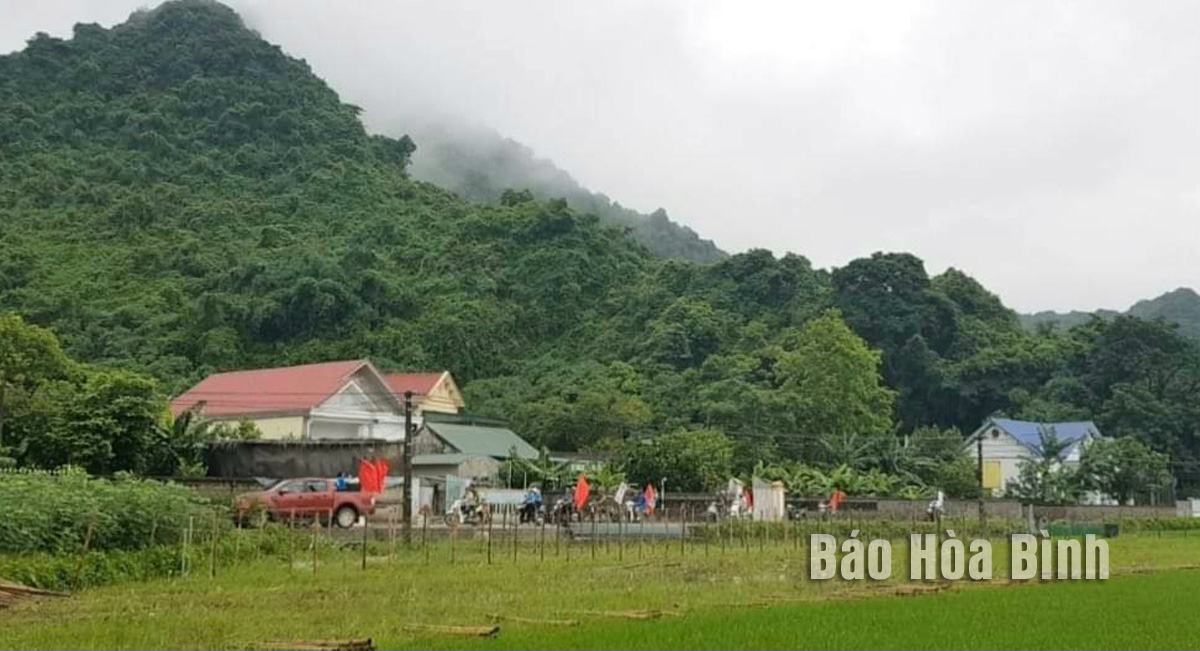
Yen Thuy district of Hoa Binh province has paid attention to mobilising resources to implement programmes, projects and policies for ethnic minorities to improve people's livelihoods and strengthen the great national unity bloc. The district currently has a total of 17,310 households, of them over 12,000 are ethnic minority families.
A corner of Nghia hamlet, Lac Sy commune, Yen Thuy district.
Lac Sy is the most remote and disadvantaged commune of Yen Thuy district with 99% of its population being Muong ethnic minority people. Vice Chairman of the Lac Sy People’s Committee Bui Van Chung said over the last few years, the commune has received investment to improve infrastructure and production. Now, it has 7 km of asphalted and concreted inter-commune roads, and 53.6% of its intra-village roads are consolidated. Irrigation works serve 85.2% of agricultural production areas. All households in the commune have access to electricity supply.
The commune’s kindergarten meets national standards, and its boarding primary and secondary schools for ethnic minority children are striving to meet national standards by the end of 2024. For years, the district has always paid attention to socio-economic development in ethnic minority-inhabited and mountainous areas. Programmes, projects, and policies for ethnic minority people have been effectively implemented by Party Committees and authorities at all levels.
Under the National Target Programme on Socio-economic Development in Ethnic Minority and Mountainous Areas, from 2022-2024, the district received over 150 billion VND, of which over 82.5 billion USD was spent on infrastructure construction. In 2024, the district was allocated nearly 68 billion VND to implement 27 projects to improve local people’s living conditions, particularly those for ethnic minorities.
Programmes, projects and policies for ethnic minorities have been implemented and achieved important results in the district. Many rural infrastructure works have been built and upgraded, gradually meeting the needs of local people, especially those in disadvantaged ethnic minority areas. Many production models are generating positive results, helping to reduce the number of poor households in the locality.
Moreover, the cultural and spiritual lives of local people have been constantly improved, and the political security, social order and safety have been maintained.
In the spirit of "Party members go first, the people follow”, all households of Party members in the Doan Ket sub-region in Da Bac town, Da Bac district, voluntarily removed gates and fences, and donated land when the road expansion project passed through their properties. Inspired by their example, 68 households in the sub-region quickly followed suit, contributing over 1,400 sq.m of residential and perennial cropland to widen the main road through the residential area. The exemplary role of Party members in Doan Ket stands as a shining example of studying and following President Ho Chi Minh’s thought, morality, and lifestyle.
The Hoa Binh provincial People's Committee held a monthly meeting on May 29 to assess the implementation of socio-economic development tasks in the first six months of 2025, the progress of key projects, and some other important issues.
During his lifetime, President Ho Chi Minh always expressed his deep affection and special concern for children and youth. He once emphasized: "Caring for and educating children well is the responsibility of the entire Party and the entire people”; "First of all, the family (i.e. grandparents, parents, siblings) must do this job well”. "the Party Committees…, the Children’s Committee, the Youth Union, the education sector, and all related organizations must have specific plans to ensure children grow healthier and more progressive”. His teachings has been remaining valuable and serving as the guiding principles in the work of protecting, caring for, and educating children. In line with this ideology, Hoa Binh Province has continuously been prioritizing and investing resources in the well-being of children in recent years.
Mr. Nguyen Phi Long, the alternate Member of the Party Central Committee and Secretary of the Provincial Party Committee chaired the meeting of the Standing Committee of the Provincial Party Committee to provide opinions on several investment projects within the province. There was the attendance of Ms. Bui Thi Minh, the Permanent Deputy Secretary of the Provincial Party Committee and Chairwoman of the Provincial People’s Council; Mr. Bui Đuc Hinh, the Deputy Secretary of the Provincial Party Committee and Chairman of the Provincial People’s Committee and other members of the Standing Committee; the leaders from other departments, agencies, and some localities.
The Standing Board of the Vietnam Fatherland Front (VFF) Committee of Hoa Binh province held a meeting on May 28 to honour outstanding village elders, village heads, and reputable individuals from local ethnic minority and religious communities.
In mid-May, the provincial Museum organised an exhibition named "Duoi la co Dang Cong san Viet Nam quang vinh” (Under the flag of the glorious Communist Party of Vietnam). This meaningful activity took place in the joyful atmosphere to celebrate the country's major holidays and the Party congresses at all levels for the 2025-2030 term, towards the 14th National Party Congress.



